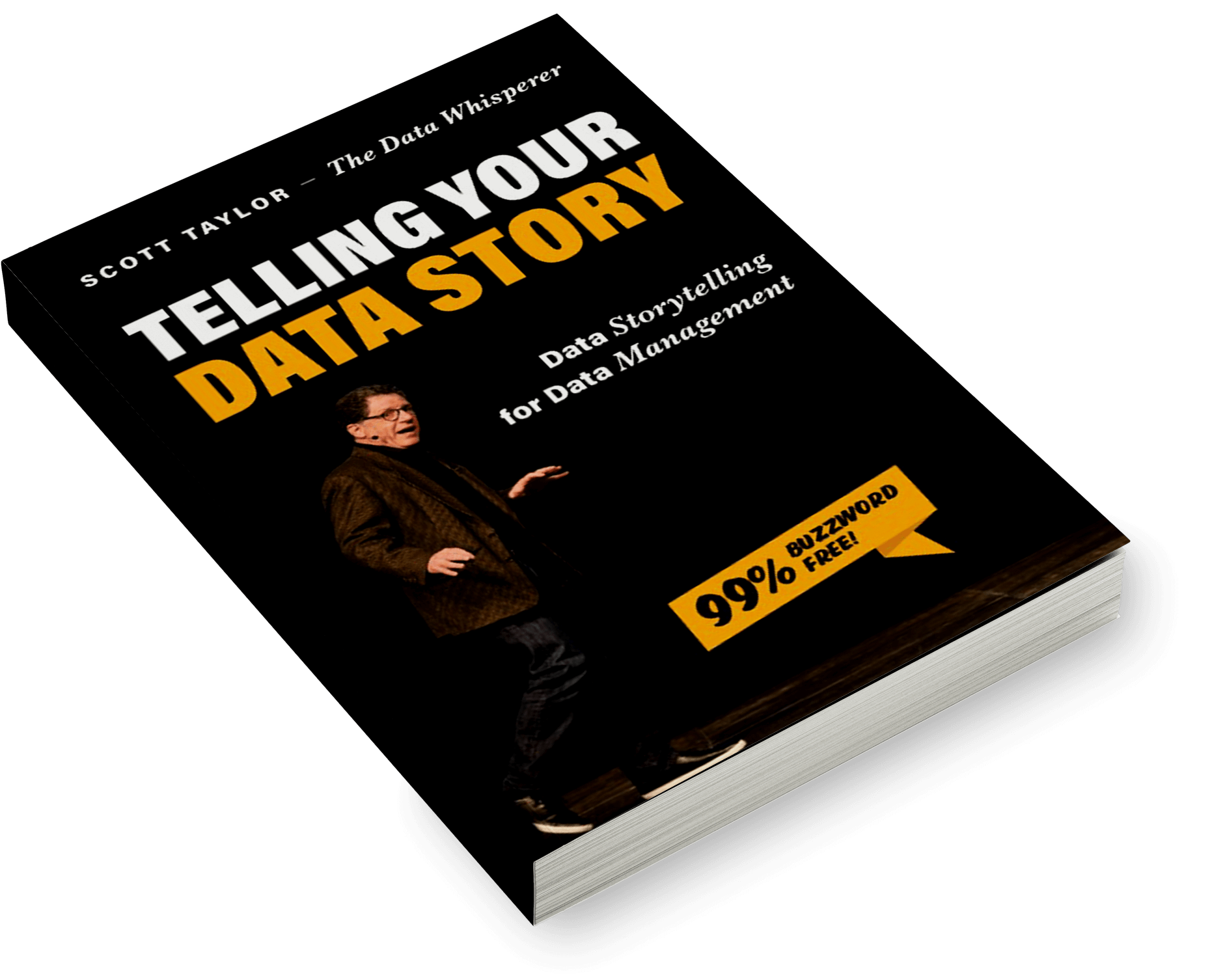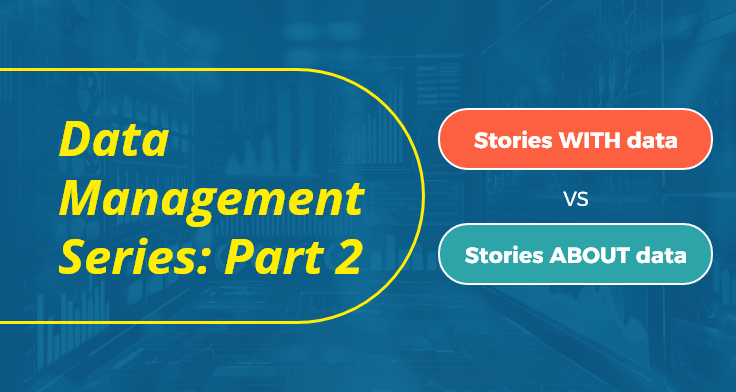To help BRIDGE THE STORY GAP between Data and The Business, we are excited to share excerpts from the book ‘TELLING YOUR DATA STORY – Data Storytelling for Data Management’ by our knowledge partner, Scott Taylor, The Data Whisperer.
There are two kinds of Data Storytelling: Stories WITH data (to support the use of analytics) and stories ABOUT data (reinforcing the importance of data management in business analytics)
In part 1 of this series, The 3V’s of Data Storytelling, we discussed the basic points of data storytelling, how to frame the conversation when you propose a data management push, and the impacts that data-driven decision-making can have on an organization. Let’s get into the specific types of data storytelling and further develop our understanding of data management strategies and future trends that may change this trajectory.
Data Storytelling and Data Literacy are probably the hottest non-technical trends in the technology-related space. Neither of them directly supports data management. That has to change.
Two Types Of Data Storytelling
Keep in mind that there are two types of data storytelling. The most popular type of data storytelling is generally about Analytics. It guides the use of insight to drive business action. Many excellent experts and thought leaders have created content to help analytics and data science professionals. Coupled with data literacy, these efforts go a long way to assist in the effective delivery and use of insights in an enterprise.
Industry experts like Kate Strachnyi, Nancy Duarte, Cole Nussbaumer Knaflic, Mico Yuk, Brent Dykes, Jordan Morrow, and Zack Mazzoncini all lead formal practices in how to better communicate with data through graphics, display, visualization, dashboarding and business-building techniques. It is a deep and vital knowledge area of crucial importance to every data-driven organization. In the Information Age, you need data management strategies and the technology to back them, or you’ll lose out to someone that has them.

It is time, however, to expand the realm of Data Storytelling to recognize the role of data management. It is the story of why that data is vital to an organization and why it needs to be managed strategically. While an analytics data story is storytelling with data and using it, the data management story is about data and making it relevant to your audience. Both are important. They are connected. Segmenting these two data storytelling types helps clarify your focus and purpose. Every organization needs to do both as part of its data and analytics strategy.
When I read Gartner’s definition of data literacy – the ability to read, write, and communicate with data in context – I didn’t see anything about data management. The majority of time and focus in the fields of Data Storytelling and Data Literacy is spent explaining analytics.
Data Management vs. Data Analytics: Understanding the Broader Context
For more context, I see two big buckets in the broader data space: data (meaning data management) and Analytics (business intelligence in a more general sense). Analytics, and the extended capabilities based on business intelligence, such as artificial intelligence, machine learning, data science, and data visualization, focus on making data more useful for an organization. This is where you derive MEANING. The activities around data management ensure data is trustworthy for an organization: data governance, data quality, data catalogs, business glossaries, master data, reference data, metadata, MDM, RDM, PIM. This is where you determine the TRUTH.
Data Storytelling techniques are not just about analytics. But if you look at the content published about data storytelling, it is devoted to tips on visualization, dashboards, charts, graphs, and other ways to explain analytics. Analytics can bring all sorts of value to an enterprise as long as the data is trustworthy. Devoid of data management, however, analytics data storytellers have no story to tell.
Data Management Storytelling: A Vital Narrative
Every enterprise has a data management story to tell. They must tell it for two specific reasons: First, investment in data management in business analytics is a crucial component for the success of the business. This investment should be an on-going, strategic data management initiative, not a one-time ad-hoc project. Most C-level business executives, company boards, and business stakeholders don’t understand that. It is not because they aren’t smart or aware—they simply haven’t been exposed to the need for data management strategies in a business-accessible way with a strategic perspective. To get their attention, they need to hear a narrative that captures their hearts and minds and convinces them that data management is not an option, but rather, the necessary shift that will propel a business further than previously thought possible. Current data management trends may shift the specifics of what can be touted as a potential benefit, but the underlying need for data management is undeniable.
Secondly, the louder, cooler, and in many cases, “sexier” trends fail without proper data management. Many massive investments are woefully underperforming. The value of every digitally transformative customer-facing initiative, every data science and analytics-based project, every as-a-service offering, every foray into e-commerce, every technological development in financial services, and every enterprise software implementation is inextricably linked to the successful output of data management efforts. Although it is a simple function of garbage in garbage out, that slogan rarely serves to drive any sustainable executive action, instead shifting the conversation to a tone of sustainment rather than growth.
Advocating for Data Management Awareness
We need to speak up. How many of you sit silently when a BI thought-leader boasts, “Without analytics, data is just a cost center” or “data has no value unless it is made into analysis.” That is your work! A baker would never say, “Flour is worthless unless I make it into bread,” because they have respect for the ingredients. There is no doubt that business intelligence provides incredible capabilities, but without proper data management, those efforts are futile. Challenge the analytics community to end this type of zero-sum portrayal of data vs. analytics value. It doesn’t help either group gain executive support.
In part 3 of this series, we will explore the story of foundational data. When your data is good, it is very, very good, and when it is bad, it is horrid.

Excerpted with permission from Technics Publications from ‘TELLING YOUR DATA STORY – Data Storytelling for Data Management’ by Scott Taylor, The Data Whisperer & Infocepts Partner.
Recent Blogs

AI-Powered Retail: 2025’s Biggest Advances and the Trends Poised to Shape 2026
November 18, 2025

Redefining Enterprise AI: The Power of Multimodal GenAI in an Agentic Era
October 30, 2025

Why Traditional HCP Engagement Fails—and How AI is Changing the Game
September 17, 2025

The Language of Care: Unlocking Patient Sentiment with AI
September 11, 2025


